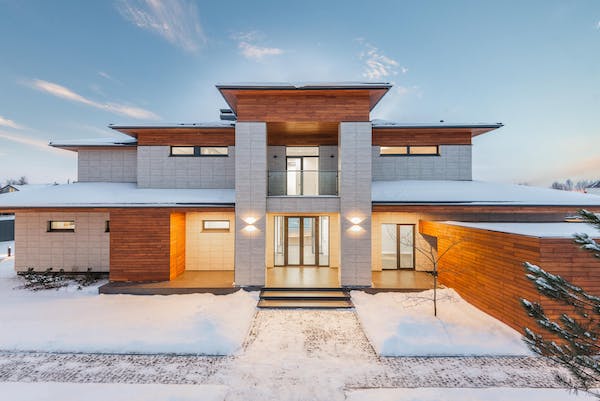As urban landscapes evolve and climate concerns intensify, the need for sustainable living options becomes increasingly evident. Enter Passive House construction, a revolutionary concept that goes beyond the conventional norms of architecture. It’s not just about constructing buildings; it’s about creating havens that seamlessly integrate with the environment while providing unparalleled comfort and energy efficiency.
Passive House construction isn’t a fleeting trend; it’s a paradigm shift in how we approach modern living. At its core, Passive House design focuses on minimizing energy consumption, optimizing natural resources, and fostering a symbiotic relationship between inhabitants and their surroundings.
This article embarks on a journey through the principles, benefits, challenges, and future trends of Passive House construction. From the insulation that envelops a structure to the strategic use of renewable energy, we explore how Passive House projects are redefining our understanding of sustainable, eco-friendly living. Join us as we delve into the heart of Passive House construction and discover why it’s not just a building technique; it’s a sustainable haven for modern living.
Principles of Passive House Construction
Furthermore, Passive House construction goes beyond traditional building practices by emphasizing the use of sustainable materials and adopting innovative construction methods. Sustainable materials, carefully chosen for their environmental impact, life cycle, and recyclability, contribute to the overall eco-friendliness of Passive House projects. The incorporation of innovative construction methods, such as prefabrication, not only reduces construction waste but also ensures a higher level of precision in assembly.
The design considerations in Passive House construction are equally paramount. Orientation and layout are thoughtfully planned to maximize solar gain and minimize heat loss, optimizing the building’s energy performance. The importance of natural light is not only a design preference but a strategic move to reduce the reliance on artificial lighting, enhancing energy efficiency. Additionally, the integration of green spaces, like rooftop gardens, adds an extra layer of insulation, promotes biodiversity, and enhances the aesthetic appeal of Passive House structures.
While the initial investment in Passive House construction may be higher than conventional methods, the long-term benefits far outweigh the costs. Reduced energy consumption translates to lower utility bills, offering a compelling economic incentive for homeowners and businesses alike. Moreover, the positive environmental impact, including decreased carbon emissions and resource conservation, contributes to a more sustainable planet.
Energy Efficiency Benefits
The energy efficiency benefits of Passive House construction are at the forefront of its transformative impact on modern living. By adhering to stringent principles of insulation, airtightness, and strategic design, Passive Houses achieve a remarkable reduction in energy consumption.
These homes or buildings require minimal external energy sources for heating or cooling, thanks to the meticulous insulation that creates a thermal envelope, keeping the interior climate stable. This results not only in a significant decrease in utility bills but also in a substantial environmental impact by reducing carbon emissions and overall energy demand.

The lower utility bills associated with Passive House living contribute to substantial long-term savings, offsetting the initial investment. Homeowners and businesses alike find that the upfront costs are a wise investment in a sustainable future. Beyond financial benefits, the environmental impact is profound, aligning with the global shift towards eco-conscious living.
As Passive House construction gains traction, its energy efficiency benefits play a pivotal role in reshaping our approach to architecture and creating a more sustainable and energy-responsible future.
Construction Materials and Techniques
Passive House construction places a strong emphasis on the selection of construction materials and the adoption of innovative techniques, making it a pioneer in sustainable building practices. One of the key aspects is the incorporation of sustainable materials that adhere to high environmental standards. From the foundation to the finishing touches, Passive Houses prioritize materials with a low ecological footprint, considering factors such as recyclability and life cycle assessments.
In addition to sustainable materials, Passive House construction embraces innovative construction techniques to further enhance its environmental credentials. Prefabrication, a method gaining popularity in sustainable building, reduces construction waste and increases precision during assembly. This approach not only minimizes the environmental impact of the construction process but also contributes to efficient and streamlined building practices.
By combining sustainable materials and innovative construction methods, Passive House construction sets a new standard for eco-friendly building, demonstrating that environmental responsibility can be seamlessly integrated into the very fabric of our living spaces. The careful consideration of materials and techniques is a testament to the holistic approach of Passive House construction towards creating structures that are not only energy-efficient but also environmentally conscious.
Passive House Design Considerations
Passive House design considerations go beyond aesthetics, focusing on strategic elements that contribute to energy efficiency, occupant comfort, and environmental harmony. One crucial aspect is the orientation and layout of the structure.
Passive Houses are thoughtfully positioned to maximize solar gain, harnessing the sun’s energy for heating during colder months and minimizing direct sunlight exposure in warmer seasons. This strategic orientation, combined with well-planned layouts, optimizes natural heating and cooling, reducing reliance on artificial climate control.
The importance of natural light is another cornerstone of Passive House design. Large, strategically placed windows allow ample sunlight to flood the interiors, creating well-lit and inviting spaces. Beyond energy efficiency, exposure to natural light has positive effects on occupants’ mood and productivity, aligning with the holistic approach of Passive House living.
Moreover, Passive House designs often integrate green spaces into the architecture. Rooftop gardens and surrounding vegetation contribute not only to the aesthetic appeal but also enhance insulation, air purification, and biodiversity. This integration of green elements reflects a commitment to creating living spaces that not only serve human needs but also contribute positively to the surrounding environment.
In essence, House design considerations redefine the concept of a home, emphasizing a symbiotic relationship between architecture and nature for a sustainable and harmonious living experience.
Cost Considerations
While House construction represents a forward-thinking and sustainable approach to building, it’s essential to consider the associated cost implications. The initial investment in Passive House construction may be higher compared to traditional building methods. This is primarily due to the use of high-quality insulation, advanced ventilation systems, and other energy-efficient components that contribute to the overall eco-friendliness of the structure.
However, it’s crucial to view this initial cost as a strategic investment with substantial long-term benefits. Passive Houses are designed to significantly reduce energy consumption, leading to lower utility bills over time. The efficiency of these structures in maintaining a stable indoor climate with minimal reliance on external heating or cooling systems translates into considerable financial savings for homeowners and businesses alike.
Moreover, when evaluating the cost considerations of House construction, it’s essential to factor in the long-term environmental and societal benefits. The reduced carbon footprint, energy conservation, and overall sustainability contribute to a healthier planet and align with the global push towards eco-conscious living. In essence, while the upfront costs may be higher, the long-term savings and positive environmental impact position House construction as a wise and responsible investment in the future of sustainable living.
Future Trends in Passive House Construction
The future trends in House construction point towards a continued evolution and integration of cutting-edge technologies and growing acceptance worldwide. As technology advances, we can expect Passive House designs to benefit from innovations in materials, energy systems, and smart home integration. These advancements may include more efficient insulation materials, enhanced renewable energy solutions, and the incorporation of artificial intelligence to optimize energy usage within Passive Houses.
Additionally, the growing popularity and acceptance of House construction suggest a promising trajectory for the future. As environmental consciousness becomes increasingly mainstream, more homeowners, architects, and builders are recognizing the value of energy-efficient and sustainable living. The upward trend in Passive House adoption is likely to drive further innovation and standardization, making these eco-friendly structures more accessible and appealing to a broader audience.
In summary, the future of Passive House construction holds exciting prospects, with advancements in technology and a cultural shift towards sustainability shaping the next generation of eco-conscious living. As these trends unfold, House construction is poised to play a pivotal role in shaping the future of the built environment, offering a blueprint for sustainable living that resonates with both environmental responsibility and modern comfort.
Conclusion
In conclusion, House construction stands as a beacon of innovation and sustainability in the realm of modern living. The meticulous adherence to principles such as insulation, airtightness, and strategic design not only makes these structures highly energy-efficient but also fosters a harmonious relationship between architecture and the environment. The focus on sustainable materials, innovative construction techniques, and thoughtful design considerations underscores the holistic nature of House construction.
The energy efficiency benefits, including reduced utility bills and a significantly lower environmental impact, position Passive Houses as not just a trend but a crucial component of a sustainable future. While there are initial cost considerations, the long-term savings and positive contributions to the planet make Passive House construction a wise and responsible investment.







